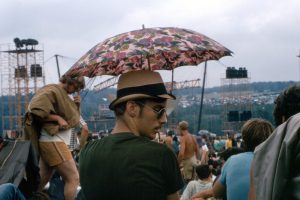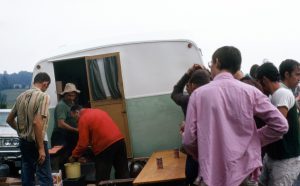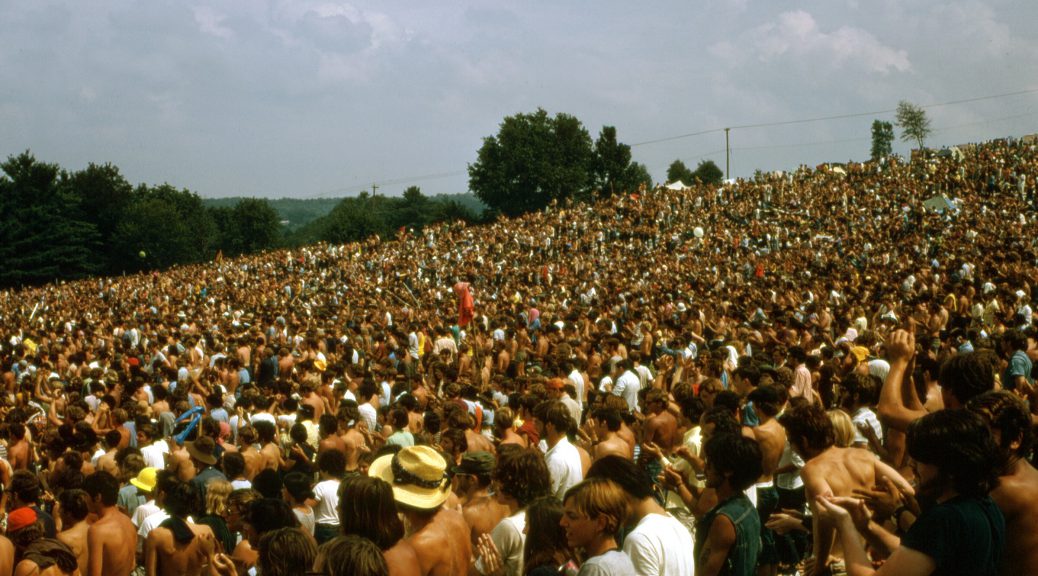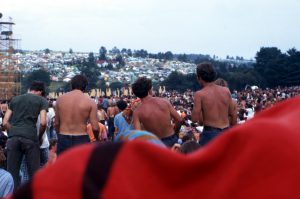Old Man Woodstock Reflections
The Irony of Woodstock
Though the 50th anniversary of the Woodstock Music and Art Fair is in our rear view mirror, many continue to reflect upon that iconic event and its impact.
Thank you to the late Charlie Maloney, Woodstock alum and a guy who “got it” when it came to what the spirit of the 60s and Woodstock has come to epitomize.
It was he, who while surfing the internet one night, found an article written by Robert Hilburn for the Los Angeles Times. It kept Charlie up later than he’d planned, but it was worth the lost sleep.
1989 was the 20th anniversary of Woodstock. Like 50, 20 was a number that summoned reflection as well.
Old Man Woodstock Reflections
Robert Hilburn
Hilburn’s point was that if Woodstock had been held in 1989 it would have been a very different event. By 1989 the commercialization of rock music had gone from the 1950s fear of rock to a late-20th century commercial embrace with branded events.
The article’s first example is Janis Joplin‘s bringing a bottle of Southern Comfort on stage with her in 1969. In 1989, such “product placement” would have cost the liquor-maker. For the article, famous concert promoter Bill Graham suggested that, “…Southern Comfort would pay her a million dollars for just holding that bottle….”
Hilburn wrote that Graham’s viewed Woodstock, “...not principally as a great musical moment, but as the day corporate America saw the big money to be made in rock. Indeed, Woodstock itself was a grand attempt to escalate the scale of rock.”
Old Man Woodstock Reflections
Woodstock legitimized Rock
The article quotes Joe Smith, a Capital-EMI exec, “Woodstock legitimized rock ‘n’ roll, and it sent out the message that there was a lot of money to be made in it.”
Lou Adler, one of the organizers of rock’s “first” festival, the Monterey International Pop Festival, said, “If Monterey made rock ‘n’ roll an art form, Woodstock made it a business.”
Old Man Woodstock Reflections
Really?
 Woodstock Ventures didn’t just lose its shirt that weekend, it lost its Army-surplus jacket, sandals, hat, and underwear. None of the four organizers, Michael Lang, Artie Kornfeld, John Roberts, or Joel Rosenman, ever got rich from it. They did continue to get plenty of grief and a mailbox full of lawsuits. Within days, Ventures sold the movie and music rights to to just begin to get out of the financial hole it found itself in. It was more than a decade later before that hole was filled. Not what I would call an acceptable rate of return.
Woodstock Ventures didn’t just lose its shirt that weekend, it lost its Army-surplus jacket, sandals, hat, and underwear. None of the four organizers, Michael Lang, Artie Kornfeld, John Roberts, or Joel Rosenman, ever got rich from it. They did continue to get plenty of grief and a mailbox full of lawsuits. Within days, Ventures sold the movie and music rights to to just begin to get out of the financial hole it found itself in. It was more than a decade later before that hole was filled. Not what I would call an acceptable rate of return.
If anything, it might be more accurate to say that corporate America saw the potential for “big money” in Woodstock’s muddy aftermath and its may brethren festivals that summer.
It’s many brethren? Until I began training as a docent at Bethel Woods Center for the Arts’ Museum, I had, as most recollect and the article implies, that Woodstock was one of the two memorable festivals that year. The other, the sad counterpoint, being Altamont and its association with Hell’s Angels violence and failed security.
Old Man Woodstock Reflections
Where were…?
That was not the case.
My research led me to dozens of other festivals that summer. None had the huge attendance that Woodstock had, but many had the same names. In fact, the lack of Black artists and Black bands at Woodstock (given the number available and touring that summer), stands in contrast to those other festivals.
For example, none of the following were at Woodstock, but appeared throughout that summer at other festivals: The Chambers Brothers, Chuck Berry, Muddy Waters, Taj Majal, Elvin Bishop, Sun Ra, Bukka White, Carla and Rufus Thomas, Ike and Tina Turner, Marvin Gaye, Albert King, Albert Collins, Edwin Starr, Slim Harpo, Big Mama Thornton, Champion Jack Dupree, John Lee Hooker, Edwin Hawkins Singers, Buddy Guy, Bo Diddley, Charles Lloyd, BB King, Little Richard, James Cotton Blues Band, Sam and Dave, Fred McDowell, Deacon John and the Electric Soul Train, or Junior Walker and the All Stars.
That same summer, Tony Lawrence helped created the Harlem Cultural Festival which featured three days of Black artists. “Summer of Love,” a movie of that event has been released.
I am not suggesting that Woodstock’s invited line-up was a biased or poor one. It was great (as were the many others). And I am certainly not suggesting that all of those listed above should have been there, otherwise the true musical coexistence that the spirit of Woodstock implies would ring hollow.
But why not any?
Old Man Woodstock Reflections
Personal view
As a Woodstock alum, myself, it is a thrill to hear “my” festival so celebrated and anointed with such importance, yet when Lou Adler stated that, ““My feeling has always been that if it hadn’t rained, we may not have heard that much about Woodstock, or at least heard about it in a different way…..More than the music, it was the story of people pulling together against all these adverse elements. That’s what made it such a dramatic and universal story” I cringe a bit.
The rain did happen, but the weekend was not a wash-out by any means. Sunburned backs attest to that.
Old Man Woodstock Reflections
Sense of Solidarity
That those of us who attended did return home with a sense of solidarity seems to be accurate. The most common theme I note after conversations with returning Woodstock alum at the Museum was the sense of “Us” that we had there and afterwards. Always remember that on that misty Monday morning when Hendrix finally closed the (actually) 4-day event, there were “only” 30- to 40-thousand people left.
Most of us had gone home. We were tired. We were hungry. We were wet. We were muddy. We wondered whether our car was still there. And we had to get back to our jobs–whether that was a full-time one or a summer job before college began.
Old Man Woodstock Reflections
Love for Sale

Woodstock’s mythic story intensified what had already begun. FM rock stations and college stations (always underrated in terms of their influence) became a bigger influences. Hillburn writes that, “Woodstock changed the progressive rock format from an experiment to a boom.”
The record industry did continue to increase its profits, but not, until the mid-70 did sales skyrocket: “$2.37 billion in 1975 . . . $2.73 billion in 1976 . . . $3.50 billion in 1977 . . . and $4.13 billion in 1978.” And those profits are credited to Woodstock’s fame.
Old Man Woodstock Reflections
Mainstream
The end result by 1989 is that the counter-cultural music scene had gone mainstream. Stadium shows with commercial sponsors and ticket prices that make Woodstock ticket-buyer wax nostalgic. The idealism of the 60s could still be found, but now part of a subset, not the primary aim.
A disillusioned Bill Graham quit the promotion business. Temporarily. He returned to help create hundreds of stadium shows and help oversee a merchandising-related company. Ironically, he died in a helicopter accident after a successful meeting with Huey Lewis about doing a benefit concert.
Old Man Woodstock Reflections
Today’s economics
Nowadays, even a not-for-profit venue like Bethel Woods Center for the Arts has to charge what seems to many to be exorbitant ticket prices to make ends meet. Ends that aren’t meet by ticket sales alone and depend on the generosity of others to close the gap and finally end in the black.
The COVID pandemic was a death knell for so many businesses and it will take years for those like Bethel Woods to recover.
Apparently the intersection of Hurd and West Shore Roads will always be a beautiful, iconic, and historic site, but not a profit-making one.



“Woodstock” by Warner Bros. won an Academy Award® for “Best Documentary Film” in 1970 and later in 1996, it was selected for preservation in the United States National Film Registry by the Library Congress as being “culturally, historically, or aesthetically significant.” The film remains the highest grossing documentary in history – being rereleased on the 40th Anniversary in digital format. The film is responsible for world-wide awareness of Woodstock – even though the original producers do not receive royalties because they were pressed to sell their rights.
Without the film, the Woodstock festival would have not been so renowned. Artie Kornfeld’s connections as a VP at Capital Records had a lot to do with making the connections to negotiate the film production. My husband, Barry Z Levine, was the still photographer on that film and worked with Michael Wadleigh and Thelma Schoonmaker even while they editing the nearly 75 miles of footage. She and Scorsese starting working on the film at Woodstock and are still working together today.
Speaking of black performers, Joe Cocker was relatively unknown and even the producers were surprised to learn he was NOT black. I thought his raspy voice would blow out early in his career – but we saw him and loved him just before our wedding. We sang “You are so Beautiful” at our event. Mike Lang was his manager for awhile.
Speaking of Bill Graham and making money. When they finished the stage and realized there were already 50,000 fans on the field with no ticket booth just a day before the concert ws to begin, Graham suggested they use cattle prods to remove the spectators and get them to “properly” return through the ticket gate. The 4 producers decided it had to be a free concert instead. Whenever there was an opportunity for confrontation the producers decided “NO.” They instituted a “please force” of clowns and vetted NYC plain clothed police. They told the Governor NOT to send in the National Guard as soldiers but as providers of food and medical supplies instead. However, back to Bill Graham, he drove Jani’s psychedelic Porsche for a few years after her death much to her fans’ disgust. (her estate sold it for more than a million).
We cover much more in our new epub -“The Woodstock Story eBook,” with over 300 color photos and over 300 active links to the celebrities, their stories and their music. Check it out.
Linanne G. Sackett – Author
From the Amazon site: Linanne G. Sackett, Ph.D. author of The Woodstock Story eBook, is a former cowpuncher, beauty queen, drag race champion, early childhood educator, realtor, economic development executive, and college Academic VP. She was working with Head Start parents in an inner city in the summer of 1969 and wrote an award winning family finance series of articles at the 5th grade reading level for immigrants and non-English speaking adults. She has has grown into a dyed-in-the-wool “Woody.” A mother and grandmother, she received an International Business Award as a leader of a high performance learning team that worked for 20 years at 26 colleges & universities across six NE states in concert with a major corporation and its unions awarding a degree in telecommunications: fiber optics. She is a judge for the International Business Awards today, and serves as President of the Brunswick Institute and Sackett Foundation.
https://www.amazon.com/Linanne-G.-Sackett/e/B002STD918%3Fref=dbs_a_mng_rwt_scns_share
Correction: oops sorry, it was not Bill Graham who drove Janis’s car, it was Albert Grossman – Barry reminded me and I stand corrected. Linanne Sackett
Wonderful article. The “magic “ was in the positive attitude of a youthful American Audience. A month after the Moon Landing, I stared at the Moon, trying to see something that was a quarter of a million miles away! lol How’s THAT for optimism! We believed that ANYTHING was possible, if we could just stop killing each other! I’m very proud of our behavior during those unsettling times. Peace was always the answer.